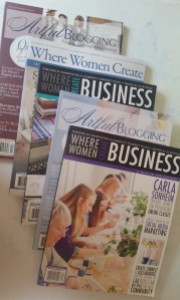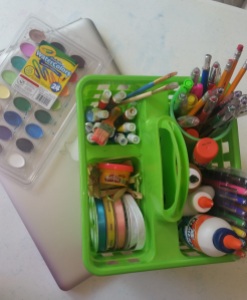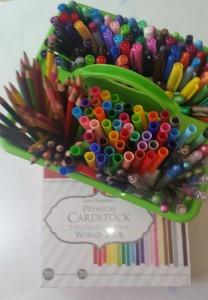
by The Creating Room | Jul 21, 2016 | artists, arts, creativity, inspiration
Many creative people have their creative toolbox that they keep on hand. They pull stuff, and tips and tricks right out of it. It’s like having a magicians magic hat. The key to a Great Toolbox is to include in it the things that will keep your creative soul going even in those times where you feel stuck or are feeling blah and uncreative.
Let’s start with what I keep in mine.
For inspiration, I have many Artful Blogger, Artful Journalling, and Where Women Create magazines, all produced by the Stampington Company. I love flipping the pages and seeing the beautiful pictures and sharing in others creative adventures. It is my hope one day to be in one of those magazines myself. It inspires and motivates me when I feel stuck or lost on what to do.
My favorite creative tool is my laptop. It is a MacBook Pro that is nearly four years old. Since I am first and foremost a writer, I find it essential for working on fiction, moving my poems from the written page to being saved and edited, and where I create my affirmation cards. I also use it for collecting my photos. I will give you a secret, I have about 22,000 pictures. NOT KIDDING. I always find reasons to use ones I thought I would never use especially in designing mini stories and affirmation cards. It is also where I create my stationary, my cards, and anything else that strikes me.
Pick your favorite tool! What is it? Keep it in good condition. If it’s something that gets used often, like a sketch book or journal, do you keep a back up so you always have one. My daughter keeps two or three around the house so she can just grab one.
Now onto some more practical, hands on stuff. Even writers need a little something out of scope of traditional writing to feed the creative soul. Here is what I highly recommend and what I keep for creative tools.
- Watercolor Paints: you can go to the dollar store and get the watercolor kits or you can go to Joanns and for ten bucks get the watercolor tubes. I use them for creating backgrounds, just playing when my mind has been so full of words, I need something that doesn’t require too much language processing.
- Pens, markers, pencils: I will admit to being an office supply junkie. I am fully addicted to new pens and pencils. I love makers, gel pens, colored pencils, Papermate Flair pens, and my fave are Pentel RSVP pens in purple. They just make writing, drawing, doodling so much more fun and interesting. Sometimes, it helps me to brainstorm in different colors to see patterns.
- Paper or Card Stock: A writer needs paper, whether hand writing or printing from a computer. If you want to make little notes or cards with writing or doodles, it helps to have sturdier card stock around and a good pair of scissors.

- Another thing that the paper is good for is making Word tiles. Inspired by Susan Wooldridge’s poem crazy. She creates word tiles and has her students draw out so many words and they have to create a poem. But I have also used them to inspire photos, or doodling or messages to friends. I think of word tiles as a great way to get out of stuckness because you have to work within the confines of the words you picked, it brings out the creative self.
- Tactile: A great toolbox as something wth texture that you can play with, touch in between or during projects. There is something about the switching of the cerebral writing, organizing to something that is just about touch. It changes our posture, calls on different parts of the brain, creates flow through other avenues. especially when stressed or up against a deadline, having some tactile object like play-dough or clay or even different types of fabric can re-direct us.
- TIME! Make sure that you give yourself time to use the tools in your toolbox. Our creative expression is of great importance. Even if you have a job and work forty hours a week, it is essential to our health that we take time for creative expression. I have said before, Brene’ Brown, a well know mental health writer, says that “UNUSED creative expression is NOT benign.” It will manifest itself in agitation, frustration, anger, guilt. A host of negative feelings that eat away at our self-esteem. So being creative helps you be a better you.
- Miscellaneous: 1) Music: I know for me when I am working on certain projects I have specific music that I listen to that creates the mood and environment that I want, especially if I am writing and I want to tune out the noise. 2) Add some acrylic paint as well. The colors are brighter and you get different results by blending. It is just a different than watercolors but fun. 3) Ribbons and stickers. These are just bits of whimsy to add to your toolbox. Maybe you only use them once in a while. I love using my own stickers to decorate packages when I send out orders. 4) Glue. All kinds but at least a good glue stick and a reliable craft glue, like Aleene’s tacky Glue. 5) A Journal. Whether you are a writer or an artist, a photographer or florist, keep a journal. They are great in offering us a chance to reflect. Maybe you just have a project journal. That’s ok. Its just another handy dandy tool for your box.

Like this:
Like Loading...

by The Creating Room | May 31, 2016 | creativity, Ten Minute Tuesday
Instead of a ten minute exercise today, I am giving some quick ideas that you can do in a five minute break. If all you have is a ten minute break, then you might only have just five minutes to do something creative or to play. Here are four great go-to ideas for a five minute play break.
- Play Dough: I keep a small container of play dough around for goofing around with. Sometimes if my anxiety is high or I am stressed this little ball of dough is perfect for squeezing and stretching and oozing through fingers. Since it is such a tactile play tool, it really helps when I have limited time.
- Watercolors: Easy to set up and easy to use. You don’t need a lot of space, money or materials to paint a quick sunrise or the ocean. Sometimes it is just as relaxing to simple play and swirl the colors around on the page, creating an abstract of some sort. I have done that and turned into backgrounds for taking pictures of affirmations and such.
- Coloring: Adult coloring books are all the rage right now. Get on board. You can even pick them up at most dollar stores now. You can even free coloring pages online. Go to Pinterest and type in coloring pages. Oodles of links will pop up. Get your Color On!
- Building Blocks, Legos: If you don’t have access to these things because you are a grown-up, after all, then build with what you do have. Just make sure it’s play. My friends’ son likes to use miscellaneous things to build like pen boxes, books, keys or just what he has on hand to build with. There is something about blocks and legos that remind us we have amazing imaginations. If you do have them, what can you build in 5 minutes? Can you use all the blocks?
Here you go, four really simple creative play tools that you can do in just five minutes. Have a grand Tuesday! Don’t forget to play!
Like this:
Like Loading...

by The Creating Room | Feb 4, 2016 | creativity, inspirational
*This post contains affiliate links.
Every creative person has their favorite books they go go when they are stuck in a rut or need a little inspiration. Books become like trusty friends that you can turn to when you need a fresh perspective or need to be reminded of something you have forgotten. The list below is compiled of books or authors that I have come back to time and time again. They are some of my favorites. A few have worn covers and tattered pages while others have been replaced because I felt compelled to hand them off to someone who needed them. A few I keep on my Nook tablet with favorite passages tagged so I can go back over them again. This list is a great beginning creative souls list. Happy Reading!
- Creativity for Life by Eric Maisel: Eric Maisel is a creativity coach in southern California. He works with artists to help unblock creative walls. In Creativity for Life, he provides examples of how he coached some of his clients and then asks the reader to participate in finding their creative goals with exercises and questions at the end of each section.
- The Artist Way by Julia Cameron: This is a must go-to for a beginning artist. The Artist Way is the first in a series of books meant to connect the artist with their spiritual nature to be in their art more authentically. I have read and re-read this book many times when I needed an artist pick me up. She incorporates many exercises to help the creative soul along.
- Billy Collins (any of his poetry books): My favorite is Sailing Around the Room and Other Poems. However, he has many and they are all great. His poetry is real and honest; he pulls from ordinary world around him to create his excellent writing. He is two-termed Poet Laureate of the U.S.
- Creating a Life Worth Living by Carol Lloyd: Carol Lloyd takes the creative person on down a path to discovering what they want from their passions. Each chapters asks the reader questions about their craft, the life they want, and other important details so they may create their own lifestyle beyond society’s norm.
- A Creative Companion by SARK (or any SARK book): Another must read for the creative being. A quick read, SARK inspires with her bright colors and handwritten pages. This a fun and lively reminder for the artist to slow-down, open their eyes, and see the world around them with their creative soul.
- poemcrazy by Susan Woolridge: A great book to read on poetry. This takes all the mystique out of poetry and breaks it down into the idea that anyone is capable of writing poetry. It is manner of learning the skills. Susan Woolridge does just that in this delightful, easy to read book.
- Writing Down the Bones by Natalie Goldberg: A “bible” of writing culture. Natalie Goldberg talks about getting to the bones in writing. A zen teacher, artist and writer, she incorporates her teachings through examples in her book. A lot of insightful information for the creative person.
- The Art of Non-Conformity by Chris Guilbreau: Here is the non-conformists BOOK! If you do not want the standard 9-5 every day lifestyle then this is the book for you. Chris tells you his story and how he went from dropping out of college to the entrepreneur that he is today. He has also been to every country in the world and incorporates some of his genius traveling hacks in this book and on his website.
- The Creative Habit by Twyla Tharp: Twyla Tharp got to where she is by one thing: she made her creative outlet a daily habit. She practices her creativity every day. It is woven through out her book that even when one feels as though they cannot create, they should continue the habit of creating to stay conscious of their art. She is a no-nonsense writer with many excellent ideas.
- Bird by Bird by Anne Lamott
A must have writers book. Anne Lamott dives into the creative side of writing but this book is also a great guideline for other creative beings. The philosophy of “bird by bird” is a concept that can be applied to any creative project that may seem overwhelming.

Like this:
Like Loading...











 Hello Everyone! I’m Susan: a Writer, Speaker, Coach and Creator.
Creativity and I have been friends since I was a kid. I was always involved in a creative project…from putting together neighborhood skits and plays, writing stories, dance, theater. I loved to play with my creative side from painting, photography, to writing...
Hello Everyone! I’m Susan: a Writer, Speaker, Coach and Creator.
Creativity and I have been friends since I was a kid. I was always involved in a creative project…from putting together neighborhood skits and plays, writing stories, dance, theater. I loved to play with my creative side from painting, photography, to writing... 